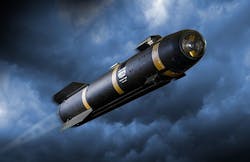Army orders half a billion dollars worth of Hellfire II laser-guided missiles for European allies
REDSTONE ARSENAL, Ala. – U.S. Army missile experts are asking Lockheed Martin Corp to build more than half a billion dollars worth of AGM-114R laser-guided Hellfire II missiles, which can be launched from manned and unmanned aircraft, surface ships, and military ground vehicles.
Officials of the Army Contracting Command at Redstone Arsenal, Ala., announced a $631.8 million foreign military sales contract on Monday to the Lockheed Martin Missiles and Fire Control segment in Orlando, Fla., to provide Hellfire II missile variants in containers for the governments of Japan and The Netherlands.
The AGM-114R is the latest Hellfire II variant, and is equipped with semi–active laser seekers to defeat many kinds of targets. The AGM-114R can be launched from several different kinds of fixed-wing aircraft and helicopters, surface ships, and military ground vehicles.
Hellfire II also is the missile of choice for several kinds of unmanned aerial vehicles (UAVs) such as the MQ-1B Predator, MQ-9 Reaper, and MQ-1C Grey Eagle. Eventually these missiles may arm U.S. military unmanned helicopters.
Related: Son of a Hellfire: JAGM meets long-overdue need for improved air-to-ground missile
The Hellfire missile weighs 106 pounds, and has high-explosive variants designed to destroy tanks and other armored vehicles, and blast fragmentation versions designed to destroy trucks, antenna sites, concentrations of enemy troops, and other soft targets.
The AGM-114R Hellfire II Romeo RX missile uses a semi-active laser guidance system and an integrated blast fragmentation sleeve warhead to engage targets that previously needed several Hellfire variants to destroy.
These missiles can seek out their targets autonomously or with designation from remote laser designators. The missile has a three–axis inertial measurement unit to enable it to attack targets from the side and behind.
The AGM-114R can be launched from higher altitudes than previous variants because of its enhanced guidance and navigation capabilities. With its multi–purpose warhead, the missile can destroy hard, soft, and enclosed targets.
Related: Army and Lockheed Martin prepare for production of advanced laser-guided Hellfire missile
Originally developed as an anti-tank missile for the Army's AH-64 Apache attack helicopter, the Hellfire homes-in on the reflected light of a laser designator. Other versions of the Hellfire are radar-guided fire-and-forget weapons.
Development of the AGM-114R Hellfire missile became necessary after the Pentagon cancelled the Joint Common Missile (JCM) project, which was to replace Hellfire, as well as the AGM-65 Maverick air-to-ground missile.
On this order Lockheed Martin will do the work in Orlando, Fla., and should be finished by September 2021. Fore more information contact Lockheed Martin Missiles and Fire Control online at www.lockheedmartin.com, or the Army Contracting Command-Redstone at www.acc.army.mil/contractingcenters/acc-rsa.
Ready to make a purchase? Search the Military & Aerospace Electronics Buyer's Guide for companies, new products, press releases, and videos

